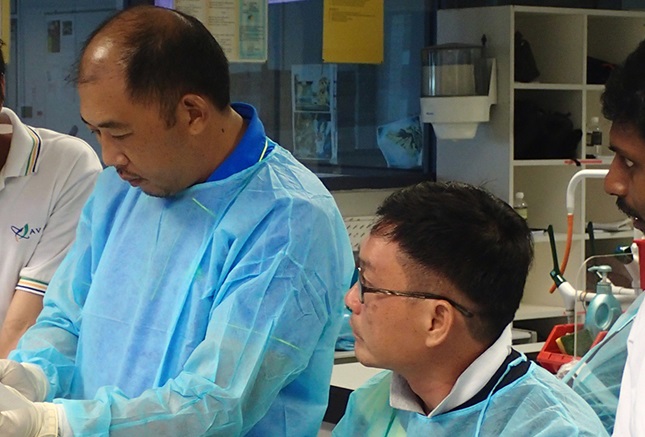Participants learn how to check the quality of water using test kits during a practical session.
Plankton are microorganisms found in the seawater that can bloom or multiply quickly (referred to as a 'bloom') in a very short period of time. Such blooms can be triggered by a combination of environmental factors, and can cause fish stock to be wiped out if farmers are ill-prepared.
To create awareness on the importance of contingency planning and resilience building in coastal fish farms, AVA organised three runs of a one-day contingency planning course in May and June 2015. Some 66 participants from 57 coastal fish farms learned about the various types of plankton that may plague local fish farms, as well as the factors that contribute to a rise in plankton population in the water.
“The different scenarios presented during the practical lesson allowed us to visualise the implementation and execution process, so that we can adapt our implementation plans according to our needs.”
Mr Frank Tan,
Marine Life Aquaculture Pte Ltd
During the sessions, AVA officers explained the technical aspects of deploying a rapid closed-containment system, which can be used as part of a contingency plan during plankton blooms. The methods of setting up necessary life support equipment, such as aeration systems, were explained in an easily understood manner, an aspect of the course that participants found particularly helpful.
"The academic terms and technical aspects were translated very clearly to something that farmers can understand and relate to," Mr Frank Tan from Marine Life Aquaculture Pte Ltd said. "This should pave the way for resilience towards future occurrence of harmful algal blooms."
AVA officers also ensured that participants had hands-on practice on how to monitor and maintain water quality in closed containment systems. "The different scenarios presented during the practical lesson allowed us to visualise the implementation and execution process, so that we can adapt our implementation plans according to our needs," added Mr Tan.
In a post-course survey, over 90 per cent of the participants agreed that the course had met its stated objectives. One of the key takeaways that benefitted participants was that plankton blooms can be mitigated with the proper planning in place.
As course participant Mr Malcolm Ong from Metropolitan Fishery Group explained: "The most important learning point is that plankton blooms are dangerous but they can be managed provided we have the system, procedure, and training in place." His farm is currently working on building a closed containment aquaculture system to reduce the potential adverse impact of plankton blooms and minimise any associated fish kills.
The course was jointly conducted by AVA and Temasek Polytechnic. The Singapore Workforce Development Agency provided participants with support in terms of course fees and absentee payroll funding.




